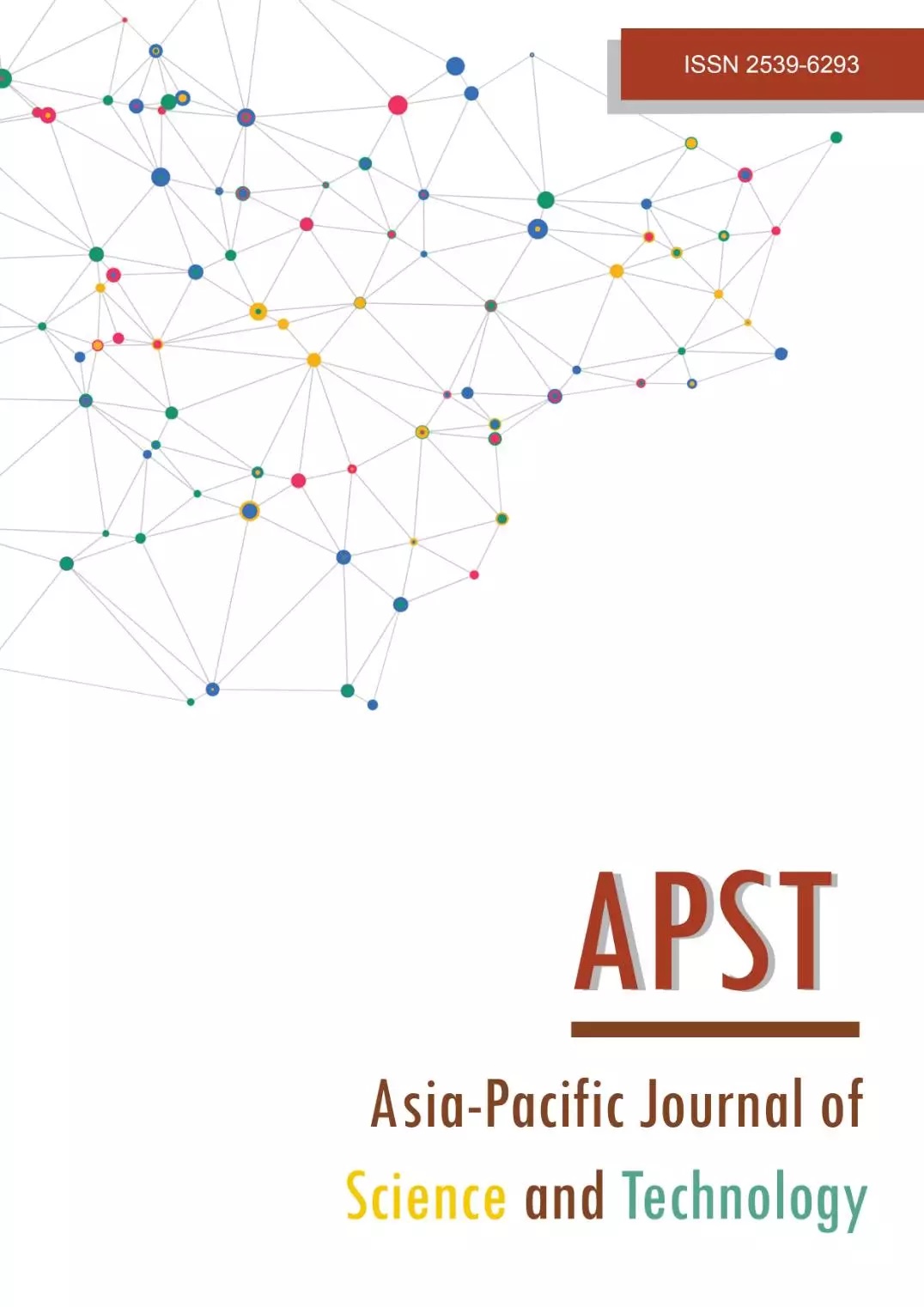Preparation of activated carbon from Phu Phan Dendrocalamus asper backer
Main Article Content
Abstract
The abstract reveal the objectives of the research and the results proposed: the objective of this research is to prepare activated carbon from Phu Phan Dendrocalamus asper backer obtained from Phu Phan district Sakon Nakhon province. The effect of chemical activation process of activated carbon was immersed in a 35% hydrochloric acid solution. The physical properties such as moisture, ash, volatile and fixed carbon contents were measured. The results were found that the optimum carbonization temperature was 550 ˚C for 2 h. The amount of ash and fixed carbon were 0.35% and 97%. It was then activated by microwave radiation at 800 watts for 60 sec. Finally, it was ground and sieved with a sieve shaker (size 75 µm). The surface area, total pore volume and pore radius were obtained by 20.47 m2/g, 0.0467 cm3/g, and 4.56 nm, respectively. The crystal structure was analyzed by X-ray diffraction and the peak positions were confirmed at the corner (14˚, 24˚, 26˚, and 29˚). The results showed that the activated carbon had a graphite crystal structure, whereas the peak in the position 30˚-50˚ was low, indicating that the structure was contaminated with amorphous carbon. An explanation for this is that during the heating process, the arrangement of carbon is the plane of graphite, and during carbonization, there is a random distribution of graphite structures, resulting in a lack of integrity in the carbon crystal structure. The average size according to scanning electron microscopy was between 60-240 µm and the Vicker hardness was 92.
Article Details
References
Phothitontimongkol T. Activated carbon from agricultural residues by chemical activation for the application of pollutant removal in water. J Res Unit Sci Tech Environ Learn. 2017;8(1):196-244.
Kanjana P, Wanna S, Walaiporn S, Daranai R, Lawan P. Water-supply rectification by using activated carbon made from Mimosapigra L. In: Watanathepin N, editor. The 1st National Academic Conference, Rajamangala University of Technology Suvarnabhumi; 2016 Jun 22; Phra Nakhon Si Ayutthaya, Thailand. Bangkok:SIRI ASKSORN PRESS Co.,Ltd. p. 222-230.
Mopoung S. Activated carbon. 1st. Phitsa-nulok; Naresuan University publishing; 2015.
Loannidou O, Zabaniotou A. Agricultural residues as precursor for activated carbon production - a review. Renew Sust Energy Rev. 2007;11(9):1966-2005.
Tan IAW, Ahmad AL, Hameed BH. Preparation of activated carbon from coconut husk: optimization study on removal of 2,4,6-trichlorophenol using response surface methodology. J Hazard Mater. 2008;153(1-2):709-717.
Prahas D, Kartika Y, Indraswati N, Ismadji S. Activated carbon from jackfruit peel waste by H3PO4 chemical activation: pore structure and surface chemistry characterization. Chem Eng J. 2008;140(1-3):
-42.
Idriss OA, Stitou M, Correa EM, González FC, García MA, Franco MF, et al. Prepa ration of activated carbons from olive-tree wood revisited. I. Chemical activation with H3PO4. Fuel Process Technol. 2011;92(2):261-265.
Yakout SM, Sharaf G. Characterization of activated carbon prepared by phosphoric acid activation of olive stones. Arab J Chem. 2012;9(2):S1155-S1162.
Sugumaran P, Susan PV, Ravichandran P, Seshadri S. Production and characterization of activated carbon from banana empty fruit bunch and Deionix regia fruit pod. J Sustain Energy Environ. 2012;3(2012):125-132.
Hesas RH, Arami AN, Duad WMA, Sahu JN. Comparison of oil palm shell-based activated carbons produced by microwave and conventional heating methods using zinc chloride activation. J Anal Appl Pyrolysis. 2013;104:176-184.
Yagmur E, Tunc MS, Banford A, Zeki A. Preparation of activated carbon from autohydrolysed mixed southern. J Anal Appl Pyrolysis. 2013;104:470-478.
Hadoun H, Sadaoui Z, Souami N, Sahel D, Toument I. Characterization of mesoporous carbon prepared from date stems by H3PO4 chemical activation. Appl Surf Sci. 2013;280:1-7.
Qin C, Chen Y, Gao J. Manufacture and characterization of activated carbon from marigold straw (Tagetes erecta L.) by H3PO4 chemical activation. Mater Lett. 2014;135:123-126.
Sayĝill H, Gȕzel F, Ȍnal Y. Conversion of grape industrial processing waste to activated carbon sorbent and its performance in cationic and anionic dyes adsorption. J Clean Prod. 2015;93:84-93.
Rajendran BA, Manivannan G, Jothivenkatachalam K, Karthikeyan S. Characterization studies of activated carbon from low cost agricultural waste: Leucaena Leucocephala seed shell. Rasayan J Chem. 2015;8(3):330-338.
Khrueakham A, Anurugsa B, Hangsapung N. Influence of chemical fertilizer application on water quality in paddy filed in Nong Harn Sakon Nakhon province. Kasetsart J Nat Sci. 2015;46(6):868-879.
Astm.org. Standard guide on metallographic laboratory safety [Internet]. Philadelphia: ASTM International c1996-2020 [cited 2020 Apr 7]. Available from: https://www.astm.org/Standards/E2014
.htm.
Anton-paar.com. Gas Sorption: surface area analysis and pore size measurement [Internet]. Florida: The Incorporation; c2018-2020 [cited 2020 Apr 7]. Available from: http:// www.quantachrome.com/gassorpt
ion/index.html.
Chotitham L, Sumanatrakul P, Kongsune P. Preparation, characterization and application for lead adsorption of Dendrocalamus asper backer Bamboo activated carbon. Thaksin J. 2016:2(19):43-51.
Ademiluyi FT, West EO. Effect of chemical activation on the adsorption of heavy metals using activated carbons from waste materials. ISRN Chem Eng. 2012:1-5.
Mahanim S, Asma IW, Rafidah J, Puad E, Shaharuddin H. Production of activated carbon from industrial bamboo wastes. J Trop For Sci. 2011;23(4):417-424.
Thai Industrial Standards Institute. Thai industrial standards of activated carbon [Internet]. Bangkok: Ministry of Industrial; 1942 [cited 2020 Jun 17]. Available from: http://research.rid.go.th/vijais/moa/full
Text/TIS900-2547.pdf.


